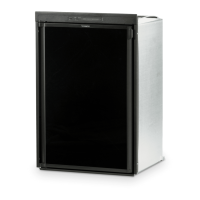27
When the ice maker thermostat senses the preset tem-
perature for ejection of the ice cubes, the ngers will start
to rotate, dumping any ice cubes and lling the mold with
water. When the storage container is full of ice, the ice
level bail arm cannot return to the DOWN position. This
will stop further production of ice until the container is
emptied and the bail arm is returned to the down position.
The absorption system will keep the compartment at the
proper temperature for storage of ice. Ice making is ac-
celerated if the thermostat is set to the coldest position. It
is a good idea to do this a few hours before you anticipate
a need for ice. The rst few cycles may have small cubes
due to air trapped in the water lines. The rst container of
ice cubes should be dumped if the water system has been
winterized or not used for several weeks.
Note: if the ice maker was cleaned and drained, no ice
cubes will be dumped into the storage container during
the rst few cycles.
10.2 Mold Heater
The mold heater uses 165 watts to thaw the ice free from
the mold. It is wired in series with the thermostat which
also acts as a safety device. With power to the appli-
ance off, check for resistance between the two leads to
the heater element. You should obtain a reading of ap-
proximately 80 ohms +/- 10%. If the heater is found to be
defective, the manufacturer recommends replacement of
the entire ice making unit for proper operation.
10.3 Ice Ejector
The ice ejector blades sweep the ice from the mold cavi-
ties during the ejection cycle. The drive end of the ejector
is “D” shaped for positive coupling. The bearings at both
ends are lubricated with silicone grease. If the ejector
blades are frozen into the ice, defrost the ice maker and
manually cycle the ice making unit, making sure the ejec-
tor stops at the right location.
10.4 Mold Thermostat
This is a single-pole, single-throw, bimetal switch. It starts
an ejection cycle by closing at 15º F ± 5º. The reset tem-
perature is 50º F ± 5º. The thermostat is in series with the
mold heater and acts as a safety against overheating in
case of a mechanical failure. If the thermostat is defec-
tive, replace it. The mold thermostat starts the ice ejection
cycle. The freezer must be down to proper temperature
for the mold thermostat to start the cycle. The cycle can
be started by turning the large gear clock wise 1/8 to 1/4
of a turn.
10.5 Shut Off Arm
The shutoff arm is cam driven. It operates a switch to con-
trol the quantity of ice produced. During the ejection cycle
the arm is raised and lowered during each of the two revo-
lutions of the timing cam. If the shutoff arm comes to rest
on top of the ice in the storage bin during either revolution,
the switch will remain open and stop the ice maker at the
end of that revolution. The arm has a manual shutoff built
into the linkage; by raising the arm as high as possible, it
will lock in that position until forced down. If the arm and
switch do not operate properly, check for damage and re-
pair or replace parts as necessary.
10.6 Mold Switches
The three switches are single-pole, double-throw style.
They are identical and interchangeable. The holding
switch assures completion of a revolution once a cycle
has started. The water valve switch opens the water
valve during the ll stage of the cycle. NOTE: This is the
only adjustable component of the ice maker. If you use a
double throw switch, DO NOT use the N.O. terminal. The
shutoff switch stops the ice maker’s operation when the
storage bin is full.

